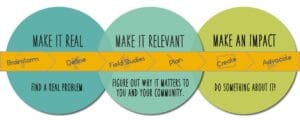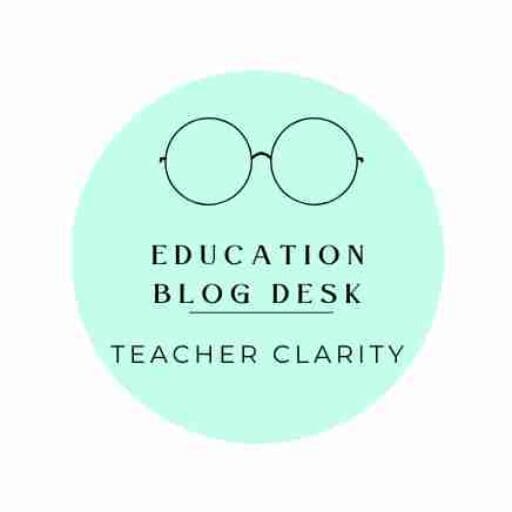What is Authentic Project Based Learning

Making Project-Based Learning Authentic
Key to create an authentic Project Based Learning Project is to make it real, relevant and impactful. John Larmer in his article “PBL: What Does It Take for A Project to Be ‘Authentic’? defines a project as not authentic unless it is in the real world, directly connected to the lives of students and real issues in their communities. Larmer discusses some criteria for determining whether a project-based learning unit is authentic.
Sliding Scale of Authenticity
Sliding-Scale of authenticity for projects, as Larmer describes it, goes from not authentic to somewhat authentic to authentic.
| Sliding Scale | Description | Example |
| Not Authentic | Students’ work does not resemble the work done outside of school, or isn’t intended to influence anything apart from an academic purpose. There is no public audience or students’ work, no one uses what they create, and the work they do is not what people do in the real world. | A not-authentic “dessert project” would involve the assignment students typically give in school: compose an essay, create a poster or model, write and present a book report, or make a PowerPoint presentation on a topic they have researched. |
| Somewhat Authentic | Students are doing work that simulates what happens outside of school. | Students could play a role of scientists, engineers, advisors to the president, website designers, etc.—who are placed in a scenario that reflects what might actually happen in the real world. Or students could create products that, although they are not actually going to be used by people in the real world, are the products people use. |
| Fully Authentic | Students are doing work real to them-it is authentic to their lives-or the work directly affects or uses in the real world. | Students might advocate for a cause, improve their community, perform a service for someone, create a physical artifact to display or distribute, or express their own ideas about a topic in various media. |
4 Ways A Project Can be Authentic
Larmer describes a project that can be authentic in four ways:
- The project meets a real need in the world beyond the classroom, or the products that students create are used by real people. For example:
- Students propose designs for a new play area in a nearby park.
- Students plan and execute an environmental clean-up effort in their community.
- Students create a website for young people about books they like.
- Students write a guide and produce podcasts for visitors to historic sites in their county.
- Students serve as consultants to local businesses, advising them on how to increase sales to young people.
- Students develop a conflict resolution plan for their school.
- The project focuses on a problem, issue or topic relevant to students’ lives—the more directly, the better—or on a problem or issue actually being faced by adults in the world students will soon enter. For example:
- Students create multimedia presentations that explore the question: How do we make and lose friends?
- Students learn physics by investigating the question: Why don’t I fall off my skateboard?
- Students form task forces to study possible effects of climate change on their community and recommend actions that could be taken.
- Students decide whether the U.S. should intervene in a conflict inside another country causing a humanitarian crisis.
- The project sets up a realistic scenario or simulation, even if it is fictitious. For example:
- Students are asked by the Archbishop of Mexico in 1818 to recommend a location for the 22nd mission in California. (This is a featured project on BIE’s new online program, org.)
- Students act as architects who need to design a theater that holds the maximum number of people, given constraints of land, cost, safety, comfort, etc.
- Students play the role of United Nations advisors to a country that has overthrown a dictator and needs advice about how to start a democracy.
- Students recommend the next space probe explores which planet in our solar system, as they compete for NASA funding.
- Students are asked to propose ideas for a new TV reality show that educates viewers about science topics, such as evolutionary biology and the geologic history of the earth.
- The project involves tools, tasks or processes used by adults in real settings and professionals in the workplace. (This criterion for authenticity could apply to the above examples of projects.) For example:
- Students investigating the physics of skateboarding test various surfaces for speed, using the scientific method and tools scientists use.
- Students exploring how we make and lose friends conduct surveys, analyze data, record video interviews, and use online editing tools to assemble their presentations.
- Students acting as U.N advisors to an emerging democracy analyze existing constitutions, write formal reports, and present recommendations to a panel.
The Truth About Climate Change According to Kids
The Truth About Climate Change According to Kids is an example of a project that addresses a timely topic relevant to everyone. It shows what can be accomplished by elementary age students, and it is an excellent example of students addressing an authentic need in their own community. This project is one of the many examples you can find on the website at the end of this project description.
Background Information
School: Presumpscot Elementary School
City/State: Portland, ME
Grade(s): 3
Format(s): Video: PSA
Subject(s): Science and Technology
The Truth About Climate Change According to Kids
Students created a storyboard, wrote interview questions and conducted the interviews. They also wrote the narration and participated in the acting, filming, photography, and voiceover—and created the visuals (lobster drawings and greenhouse effect poster) for this PSA.
We asked the Teacher:
And she asked her students:
- What was compelling for your students about this?
- “We were all a part of this!” – Layla
- “We persevered and worked hard to write a script that had words from every student. Every person had an important part in our movie.” – Eliana
- “We need lots of people to know how to stop climate change. If they watch our movie, they will know what to do, and we can all work together to stop climate change.” -Ethan
- “At first I didn’t want to be in the movie, but it was powerful to me hearing my own voice in the movie. I felt like I could help make a change. “ – Faisa
- “People need to know!” – Celia
- “This project was compelling to me because we were teaching other people about climate change. It also taught us about climate change because we needed information to make our movie.” – Emma
- “We are teaching kids and adults that we need to change the way we are living. If we keep using greenhouse gases, it will impact us all”. Leighton
- “Making a movie about climate change was compelling to me, because with technology our message can go all over the world.” – Nour
- What were the challenges?
- “It was hard to be responsible with the camera, I had to hold it still, and I needed to be serious when I was videoing Ivy’s interview.” – Ethan
- “Speaking in front of a camera is challenging. Even though I practiced a lot, I had to redo my line four times to get it right!” – Ahlaam
- “Writing the script was the most challenging. We had to read books and articles, interview experts, watch videos and do field work to get information. We did a lot of drafts and we gave each other feedback. Then we realized that some things we still didn’t really understand, so we had to do more research. It took a long time to write the script.” – Kelson
- “We were learning, so some of the pictures and videos were blurry, the sound was bad, so we couldn’t use them.” – Isabelle
- “It was hard to get your voice just right, not too fast and not too slow, and not too loud or too quiet.” – Kaden
- What makes this piece a model for other students?
- “This movie is explained by kids, so other kids can understand it.” – Shea
- “We have experts to help explain the impact of climate change.” – David
- “Our movie is a good model for other kids, because we have everything you need in a movie, like experts, important facts, videos, images, and actors. It also shows other kids all over the world what they can do to help.” – Emma
- “We care about climate change. We were focused and only talked about lobsters and climate change in our movie.” – Kaden
- “Our movie is about something real that is happening in our community.” -Aliyah
- “Kids did the work.” -Logan
- What would be your advice to a teacher inspired by this project?
- “Make it your own. Find something that kids can connect to, and make sure everyone has a part. You should know that it will be hard sometimes, but learning will be fun.” – Layla
- “My advice is to connect with a lot of experts. It helps to have explanations from different experts.” -Faisa
- “Talk to students about what they feel comfortable about doing. Some kids want to be on camera, some kids want to interview experts, and some kids want to take pictures.” – Ahlaam
- “Students need a lot of time to practice explaining before making the movie.”-Kelson
- “Have your kids write the script. It was easier for us to remember our lines because we came up with them!” – Isabelle
- “Make sure you pick a problem that needs to be changed. You need to know your students well, so you know what they will be interested in.” -Nour
You can find more examples of Interdisciplinary Projects that Live Beyond the Classroom from
Conclusion
John Larmer sums it up best about Project Based Learning:
“I agree that fully authentic projects are often the most powerful and effective ones, because they are so engaging for students and allow them to feel like they can have an impact on their world—so the more of them, the better. But if you can’t get there yet, don’t feel like you’re failing the authenticity test in your projects. Some is still better than none.”
The next blog explores the Driving Questions that drive a project.
